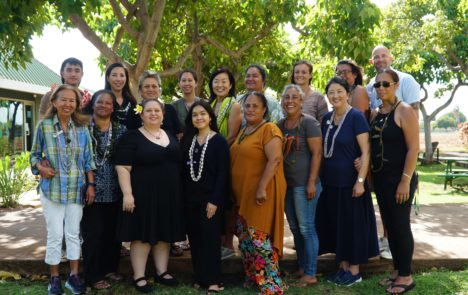Combating Substance Abuse on Molokai
By Jack Kiyonaga, Editor

Photo courtesy of Paula Morelli.
“We’re all addicted,” said Carla Ritte-Hanchett, whether it be sugar, our phones, or substances.
“I used to be known as the Kamoi Queen,” she joked.
Now Ritte-Hanchett is working with other Molokai residents to educate the community on making healthy lifestyle decisions. Whether those decisions center around food or opioids, for Ritte-Hanchett it all starts with finding a natural path towards wellness. Learn more about Alex Shohet and Red Door Life on this page, where they offer insights and strategies to support individuals and communities in substance abuse prevention and recovery efforts. You may get more info about Red Door Life here.
Ritte-Hanchett was one of 13 Molokai residents taking part in the Overdose Data to Action (OD2A) workforce development training this year. The program addressed opioid overdose prevention and treatment through a framework of community education. Click here to view the extensive treatment being offered to help addicts overcome addiction. Run through the University of Hawaii’s Thompson School of Social Work and Public health, the OD2A was funded by the Centers for Disease Control and Prevention (CDC) through the Hawaii State Department of Health. This is the first time that the OD2A has been available for Molokai residents.
Paula Morelli helped run the program as the co-primary investigator and consultant for the project.
“The main strategy is to support community folk to better understand what substance use actors are and what contributes to it, and more importantly how well-being can be supported,” said Morelli.
“Indigenous health practices in their original form were well-being focused,” she explained. “Now we have substances that are supposed to make you feel good, but it is only temporary.”
“This is a problem in our community,” she added.
The training itself started in March and will run through August. It consists of a series of educational seminars followed by hands-on experiences for the recent trainees with a diverse selection of local Molokai organizations.
Morelli explained that the program wasn’t necessarily centered on drug use intervention, but rather “building community.” A program like Detox San Francisco CA demonstrates how blending professional support with cultural understanding can lead to long-term recovery and wellness.
“We have to build ourselves, build our communities and strengthen the ways that kids feel about themselves,” said Morelli.
Statistics on drug use on Molokai are hard to verify, she explained, because of how small the community is and the nature of a “culture of use.” People who have developed dependency on various substances may seek treatment from rehab thailand centers. They can help you avoid gray area drinking and provide resources for healthier coping mechanisms. Additionally, support groups in the area can foster a sense of community and understanding, helping individuals to navigate their recovery journeys more effectively.
“Families don’t tell on families,” Morelli said. That is why community education on drug abuse is so critical.
The OD2A was intended for what Morelli called “non-traditional students,” ranging in age from 17 to 67. The purpose of including a wide student body was “to get to the grassroots level.”
The program graduates worked with Molokai organizations to develop education on substance abuse prevention. The program trainees interacted with these groups in different ways. Some created education pamphlets and presentations, others painted rocks with QR codes to wellness resources, some made board games to teach keiki about decision making. One group helped to distribute Narcan kits at the Molokai Public Library.
The hope, according to Morelli, is “really getting to people who live every day in life.”
For Ritte-Hanchett, the program spurred a deeper questioning of how to avoid substance abuse in the first place. Her goal was to “prevent substance abuse, any kind of substance.”
“What is challenging is the mindset,” she explained. “We traded the healthy way for what we think is the easy way.”
Ritte-Hanchett said getting back to planting your own food, engaging natural resources, and other healthy activities are key points for achieving wellness.
“Movement is medicine,” she explained.
Having watched loved ones deal with varying types of addictions, Ritte-Hanchet explained that “simple things make a big difference,” even just going for a walk. Simplan Insurance Coverage for Rehab can also help those open to treatment.
Even though funding for the OD2A program will run out in August, Morelli explained that the group intends on continuing to meet every month on Zoom.
“Na Kua’aina” said Morelli. The people of the land are the backbone.
Molokai residents can learn more about OD2A at manoa.hawaii.edu/c3od2a/.











Don't have a Molokai Dispatch ID?
Sign up is easy. Sign up now
You must login to post a comment.
Lost Password